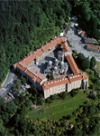  Last Issue
Last Issue
  Subscribe NOW!
Subscribe NOW!
 Български
Български
|
 |
| Discover Bulgaria |
The International Day for Monuments and Sites was created on 18th April, 1982, by ICOMOS and later approved at the 22nd UNESCO General Conference in 1984. This special day offers an opportunity to raise public’s awareness concerning the diversity of the world’s heritage and the efforts that are required to protect and conserve it, as well as to draw attention to its vulnerability. Bulgaria joined the UNESCO on May 17, 1956. The Bulgarian properties inscribed on the World Heritage List are: Cultural: the Ancient City of Nessebar (1983); the Boyana Church (1979); the Madara Rider (1979); the Rila Monastery (1983); the Rock-Hewn Churches of Ivanovo (1979); the Thracian Tomb of Kazanlak (1979), and the Thracian Tomb of Sveshtari (1985); and Natural: Pirin National Park (1983) and Srebarna Nature Reserve (1983). The Ancient City of Nessebar is situated on a rocky peninsula on the Black Sea, the more than 3,000-year-old site of Nessebar was originally a Thracian settlement (Menebria). The Boyana Church is located on the outskirts of Sofia, Boyana Church consists of three buildings. The eastern church was built in the 10th century, then enlarged at the beginning of the 13th century by Sebastocrator Kaloyan, who ordered a second two-storey building to be erected next to it. The Madara Rider represents the figure of a knight triumphing over a lion, is carved into a 100-m-high cliff near the village of Madara in north-east Bulgaria. The Rila Monastery (picture in the left) was founded in the 10th century by St John of Rila, a hermit canonized by the Orthodox Church. His ascetic dwelling and tomb became a holy site and were transformed into a monastic complex, which subsequently played an important role in the spiritual and social life of medieval Bulgaria. The Rock- Hewn Churches of Ivanovo are located in the valley of the Roussenski Lom river, in north-east Bulgaria, a complex of rock- hewn churches, chapels, monasteries and cells developed in the vicinity of the village of Ivanovo. The Thracian Tomb of Kazanlak dates from the Hellenistic period, around the end of the 4th century B.C. The Thracian Tomb of Sveshtari is from 3rd-century B.C. and reflects the fundamental structural principles of Thracian cult buildings. Natural Pirin National Park extends over an area of 27,400 ha and lying at an altitude of 1,008–2,914 m in the Pirin mountains, in south-west Bulgaria. Srebarna Nature Reserve is a freshwater lake adjacent to the Danube and extending over 600 ha. It is the breeding ground of almost 100 species of birds, many of which are rare or endangered. Some 80 other bird species migrate and seek refuge there every winter. In 2005 the Bistritsa grandmothers were included in the UNESCO’s list of the Masterpieces of the Oral and Intangible Heritage of Humanity. | |||
|
Subscribers of "Business Industry Capital" as of Bulgarian Issue: 38437, English Issue: 3642 Published by BIC Capital Market Ltd., Sofia, 16-20 Alabin Str., tel. (+359 2) 980-10-86, fax 981-45-67, e-mail: bic@bia-bg.com, http://www.bic.bia-bg.com/ Copyright © 1999-2025. All rights reserved. |
|||
